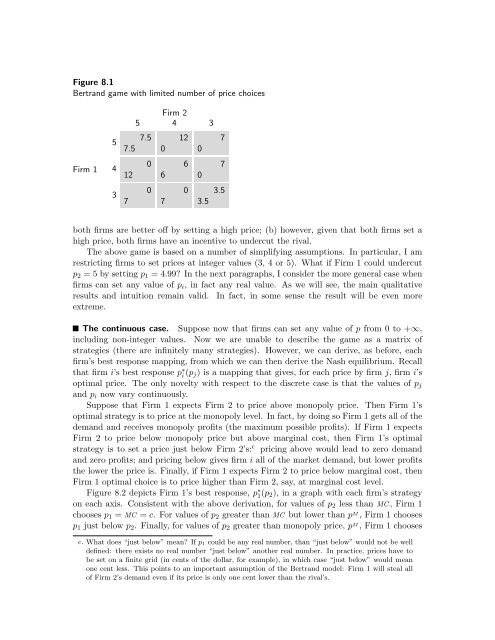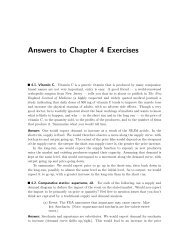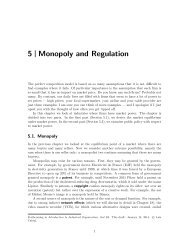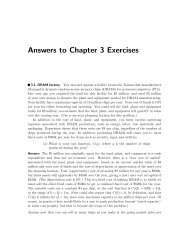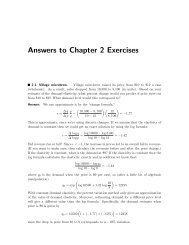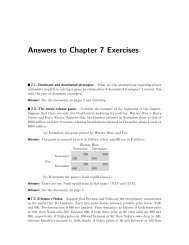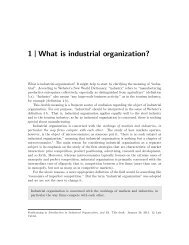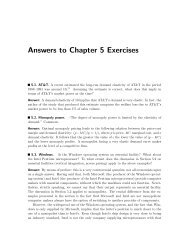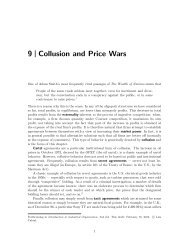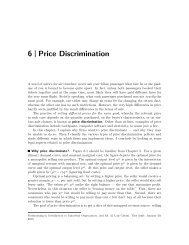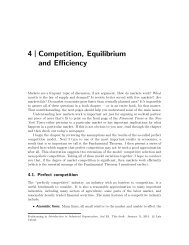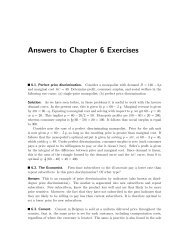8 Oligopoly - Luiscabral.net
8 Oligopoly - Luiscabral.net
8 Oligopoly - Luiscabral.net
You also want an ePaper? Increase the reach of your titles
YUMPU automatically turns print PDFs into web optimized ePapers that Google loves.
Figure 8.1<br />
Bertrand game with limited number of price choices<br />
Firm 1<br />
5<br />
4<br />
3<br />
Firm 2<br />
5 4 3<br />
7.5 12 7<br />
7.5 0 0<br />
0 6 7<br />
12 6 0<br />
0 0 3.5<br />
7 7 3.5<br />
both firms are better off by setting a high price; (b) however, given that both firms set a<br />
high price, both firms have an incentive to undercut the rival.<br />
The above game is based on a number of simplifying assumptions. In particular, I am<br />
restricting firms to set prices at integer values (3, 4 or 5). What if Firm 1 could undercut<br />
p 2 = 5 by setting p 1 = 4.99? In the next paragraphs, I consider the more general case when<br />
firms can set any value of p i , in fact any real value. As we will see, the main qualitative<br />
results and intuition remain valid. In fact, in some sense the result will be even more<br />
extreme.<br />
The continuous case. Suppose now that firms can set any value of p from 0 to +∞,<br />
including non-integer values. Now we are unable to describe the game as a matrix of<br />
strategies (there are infinitely many strategies). However, we can derive, as before, each<br />
firm’s best response mapping, from which we can then derive the Nash equilibrium. Recall<br />
that firm i’s best response p ∗ i (p j) is a mapping that gives, for each price by firm j, firm i’s<br />
optimal price. The only novelty with respect to the discrete case is that the values of p j<br />
and p i now vary continuously.<br />
Suppose that Firm 1 expects Firm 2 to price above monopoly price. Then Firm 1’s<br />
optimal strategy is to price at the monopoly level. In fact, by doing so Firm 1 gets all of the<br />
demand and receives monopoly profits (the maximum possible profits). If Firm 1 expects<br />
Firm 2 to price below monopoly price but above marginal cost, then Firm 1’s optimal<br />
strategy is to set a price just below Firm 2’s: c pricing above would lead to zero demand<br />
and zero profits; and pricing below gives firm i all of the market demand, but lower profits<br />
the lower the price is. Finally, if Firm 1 expects Firm 2 to price below marginal cost, then<br />
Firm 1 optimal choice is to price higher than Firm 2, say, at marginal cost level.<br />
Figure 8.2 depicts Firm 1’s best response, p ∗ 1 (p 2), in a graph with each firm’s strategy<br />
on each axis. Consistent with the above derivation, for values of p 2 less than MC , Firm 1<br />
chooses p 1 = MC = c. For values of p 2 greater than MC but lower than p M , Firm 1 chooses<br />
p 1 just below p 2 . Finally, for values of p 2 greater than monopoly price, p M , Firm 1 chooses<br />
c. What does “just below” mean? If p 1 could be any real number, than “just below” would not be well<br />
defined: there exists no real number “just below” another real number. In practice, prices have to<br />
be set on a finite grid (in cents of the dollar, for example), in which case “just below” would mean<br />
one cent less. This points to an important assumption of the Bertrand model: Firm 1 will steal all<br />
of Firm 2’s demand even if its price is only one cent lower than the rival’s.


